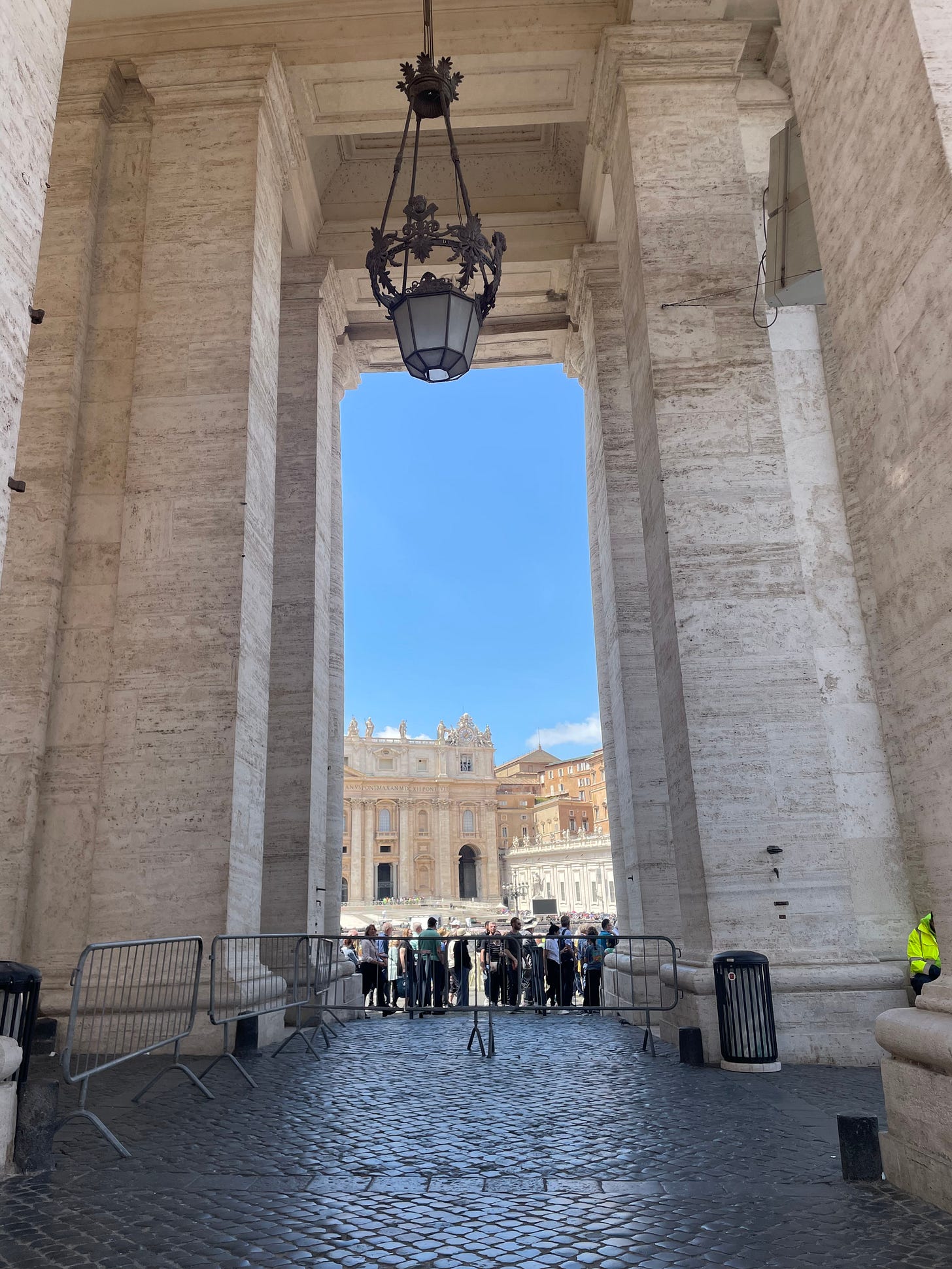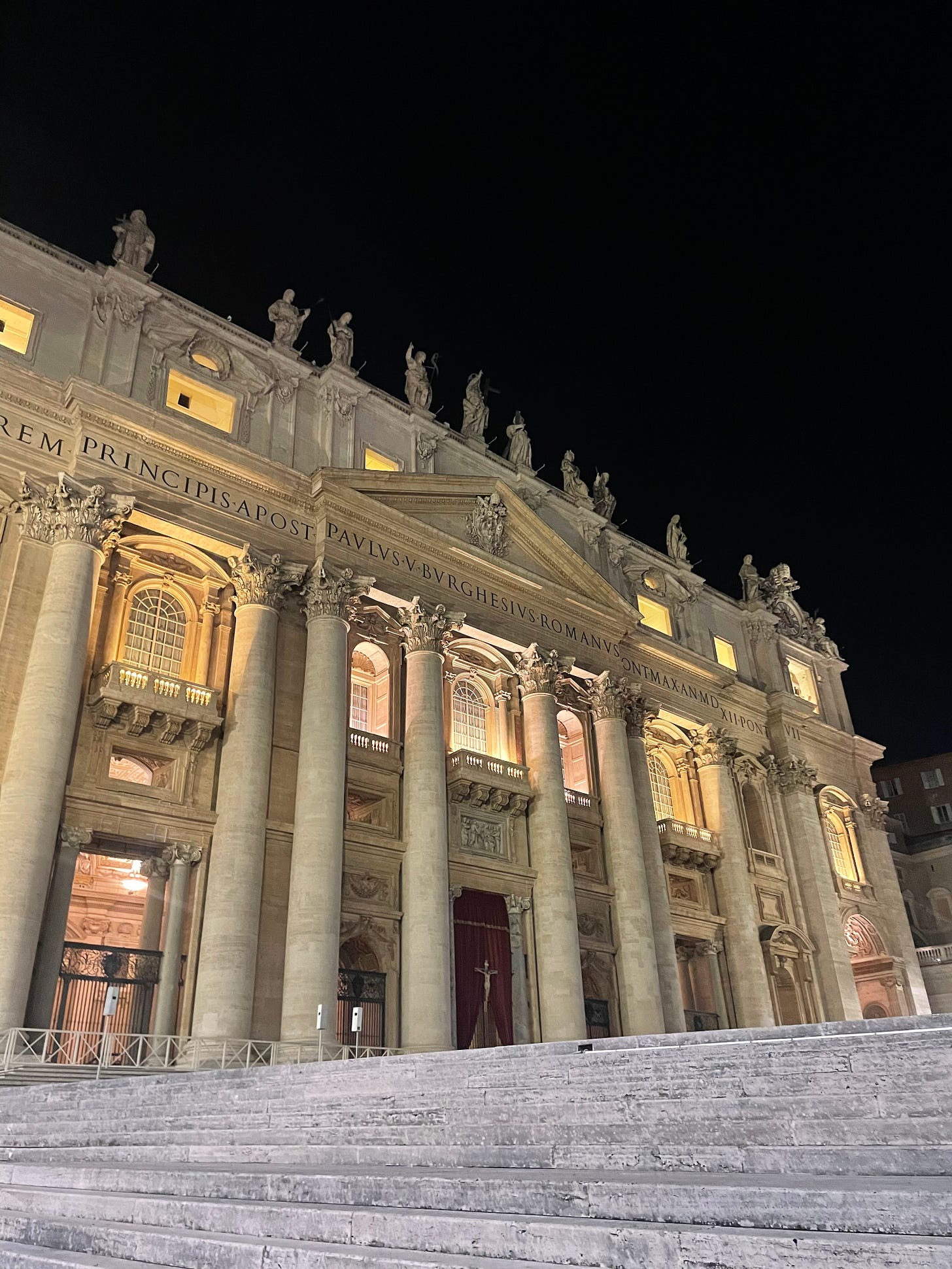The threat of Pope Francis’ death had at first hung over the city of Rome like a funeral pall since mid-February, when the head of the Catholic Church was hospitalized with double pneumonia and the daily release of news seemed to bring brief blips of calm only to be proceeded by more and more grave health updates. Each morning began with a collectively drawn-in breath, as if the city was physically preparing itself for what was to come.
But in late March, after more than a month in Policlinico Gemelli, Pope Francis was released, sent back to his home at Casa Santa Marta, and this latent gloom gave way to a tepid relief. Suddenly, whispered talks of conclave, how the world would react and who might be next dissipated. The never-ending rumor mill had now been immediately silenced.
Francis’ return was quiet, marked by a number of unscheduled visits. He went to pray at Santa Maria Maggiore, the church he made sure always to salute departing and returning from apostolic trips. He surprised crowds in St. Peter’s when he appeared at the end of a mass for the sick and those who worked in healthcare. He managed to once again make geopolitical headlines when he met with U.S. Vice President JD Vance, despite his thinly-veiled past criticisms of Vance’s understanding of theological teachings. And he stunned the public on Easter Day when he emerged in the popemobile.
That Francis would die, at some point, was certain—this final verdict comes for us all. But now that the immediate fog had lifted, his eventual passing was once more relegated to a topic of the future. Perhaps not so far off, it was true, but certainly not imminent.
At least, that was my spectator’s take, which I was inclined to believe. Anyone who has witnessed someone suffering from a long illness knows that it is futile to predict when a person might die. Bad days follow good days, good days in turn follow bad, and there is certainly no kind of linear trajectory.
Yet my dear friend, a keen student of church history and a faithful Catholic, countered this argument at Easter lunch. His view of Francis’ outings to Santa Maria Maggiore and to St. Peter’s was simple: “He knows he’s dying, and he’s taking these last moments.” This struck me as impossible, that one could really know they were dying and act accordingly.
But when we all awoke the next morning, at least on my part without any kind of drawn-in breath, my friend’s analysis would turn out to be correct. The news was everywhere—the Pope had passed away early Monday.
As reported by Vatican News’ Salvatore Cernuzio, Francis had the first signs of his departure at 5:30 a.m., only to offer a goodbye gesture with his hand nearly an hour later to his personal medical assistant, Massimiliano Strappetti, and fall into a coma. Just the day before, when Easter crowds in the piazza were at roughly 50,000, he had asked Strappetti if he thought he was capable of a ride in front of the public. Cernuzio wrote that the Pope “wanted to offer a last surprise, one that meant something, going for a ride in St. Peter’s Square in the popemobile.”
The Pope’s words to Strappetti afterwards were, in fact, prescient: “Thank you for bringing me back into the piazza.”
Francis’ obituaries, likely prewritten for the occasion, followed en masse with the news of his death. Here, I will quote from
by , as I think he does a great job summarizing the wider take on the Pope (and I recommend his newsletter in general for anyone interested in Italy.)The liberal press has seemingly synchronised its verdict. Francis was a progressive reformer, but he was also “a disappointment,” or so the story goes. He was a visionary but he was “inconsistent.” He was, by general consensus, a “good” leader, a moral “counterbalance” to right-wing populists, but still a Pope, the product of a corrupt institution which, as Francis himself admitted, is seemingly unreformable.
In a series of more personal reflections, the Vatican and Italy press corps also reckoned with what it meant to cover the Pope. I listened with fascination to The Daily’s interview with New York Times Rome bureau chief Jason Horowitz, who outlined the various anecdotal moments of Francis’ career that defined his legacy, including his very first papal address. “Fratelli e sorelle, buonasera,” he said, which Horowitz notes was significant for its implied intimacy. Associated Press reporter Nicole Winfield reflected on Francis’ nickname for her, “la prima della classe,” shedding light on his decision-making process and how his relationship with the media changed over the course of his papacy. In all of the coverage, there was an overwhelming sense that Pope Francis was someone you could actually touch, a presence that did not seem merely ceremonial but really human.
By Tuesday evening, I had made my way to St. Peter’s, struck by a strange eeriness in the air. It wasn’t quite devastation I noticed, having expected to see people bursting into tears at random, but a dismal quiet. On Wednesday, Francis’ body was moved into St. Peter’s Basilica in a somber ceremony and the faithful lined up for hours to say a final goodbye. My very same friend waited in line for more than four hours with his group of pilgrims to enter the church.
Yet the Romans are also a group prone to irreverence. “Have you heard the phrase, ‘Morto un papa, se ne fa un altro?,’ an [American] friend of mine texted me, the idea being that any of us, even the Pope, can be replaced.
Like many in my general age group, us rotted-by-the-Internet millennials, I have had a conflictual relationship with my faith, with any faith. I was raised in the Greek Orthodox church, but that often felt more like a cultural home, a way of staying true to my Mediterranean roots, than a spiritual one.
It was only when I stopped living with my parents that I started to really question my relationship with religion. What did it mean to believe in God? Why did we go to church? Was I connecting to a higher power or simply adhering to what felt like an innate obligation? I was 18, so these all felt like deeply philosophical questions.
But life, as it always does, answers the questions we don’t even think to ask, not in expedient ways and certainly not always in ways that make sense. That summer, my beloved grandmother had suddenly and unexpectedly been diagnosed with a brain tumor. There was no ambiguity here—this was a matter of “when” and not “if.”
Expecting someone’s death doesn’t make it any easier. Instead, I found myself completely numb to my grief. My grandmother was here, but not quite, and while we had known she wouldn’t be here forever, the opposite of forever was now creeping ever closer with each day.
Still, there were few moments I could access the terror I felt, and when it did manage to escape, I worried it might never leave. After receiving some particularly bad news, I remember meeting with my impossibly glamorous Renaissance Architecture professor to discuss the upcoming final exam and sobbing in her office. All I could sputter out was “my grandmother,” because I didn’t know what to say. The reality was unutterable, even and especially to myself.
There was only one place that my emotions could eke out in a way that felt cathartic, safe even. Perhaps it was only fitting, given that my grandmother was a devout worshipper, that it would be in the pews of a church. Each Sunday, I shuffled into the immense Gothic chapel on my university’s campus, not because I was a congregant, but because I sang in the school’s Chapel Choir. The church is considered ecumenical, but the beaming sound of the organ and the imposing architecture of the place offered the essence of High Church.
At the very end of each service, as part of a tradition, we fanned out to every corner and sang “God Be in My Head,” a lilting hymn that ends with “God be at mine end and in my departing.” And each time, as if on cue, I felt the pressure of tears start to well in my eyes and spill into the edges of my vision. Some of it was a pure physical response—I was overwhelmed by the song, by the space, by the tenderness of it all. But I also knew that my body was trying to resolve something that it simply couldn’t logically. In my grief, I never felt as close to my grandmother as I did on those mornings.
I noticed that same sense of unity in the week after Francis’ death in Rome. It was as if the whole city had stopped, not so much out of the purity of mourning as out of the purity of significance. The final legacy his papacy will leave is perhaps not a judgment any of us can really make. What we can say is this—we bore witness to the end of an era. It is anyone’s guess what the next one will bring.






Beautiful.
Love love this piece!